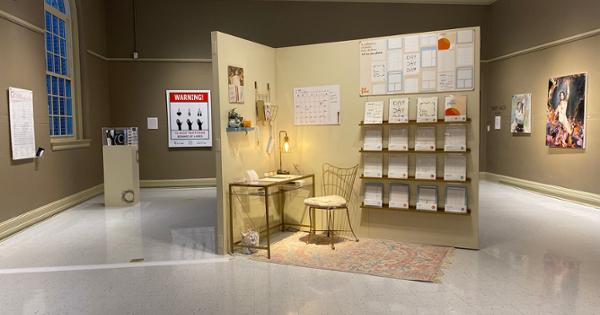JOHNSON CITY, Tenn. (April 8, 2022) – The East Tennessee State University Department of Art and Design and the Reece Museum present the Spring 2022 BFA Senior Exhibition on display through April 22. The exhibition features 10 Bachelor of Fine Arts students: Mads Brewer, Dana Brown, JJ Cox, Jenesis Fisher, Erin Fitzgerald, Emily Flores, Keely Melton, Sierra Stanley, Eric Terry and Haeden Willis. A reception happens Tuesday, April 12, from 5-7 pm at the Reece Museum.

Here’s a look at the displays:
“The Derivative” is a recreation of a family computer room in which the primary user is captivated by the use of samples in music. Brewer shows the thought process and research this person does by including a series of purposefully hand-crafted investigations of sampling. These investigations take form in a timeline of sampling, a breakdown of this person’s favorite songs and their samples, and a printed quilt which features the faces of significant musicians in this art form.- “Final Girl Survival Co.” is Brown’s solution to a gap she saw in the fashion industry between trendy, everyday styles and self-expression. She grew up the “odd one out,” she wrote, since her love of horror movies began at a young age and she was always shocked to find others who shared her passion. Her brand takes a stab at the stereotypes of classic slasher movies in an effort to show off this interest through self-expression by clothing.
- In the “Alpha Male” exhibit Cox talks about the topic of his experience as a single dad with two daughters and how it has affected his masculinity. While walking through the exhibit you will discover how in contemporary American society, “some men are concerned about being seen as an alpha or beta male,” he wrote. “It is common that these men even degrade women as if they are inferior to themselves.” Cox goes against this idea with not only the presentation of his artwork but the story behind each piece. His work shows examples of himself and other single fathers in nature.
- Fisher’s exhibition, entitled “Jot Plot,” is about a custom style planner. The planner book itself was constructed with book binding board and a three-ring binder mechanism to hold the customizable planner pages, but can also be used to insert any handouts that the user may need. Each page was designed with minimalistic design qualities so that there are not too many distractions. Although “Jot Plot” was designed to reach out to the audience of “neurodivergent minds,” she wrote, “it can be used by anyone that needs a tool to organize their life.”
- Erin Fitzgerald’s exhibition “Baby Hair” addresses the traumatic childhood experiences that continue to affect her life. As a child, she struggled to articulate her emotions properly, repressing them or allowing them to smother her sense of self, she wrote. Giving these experiences form and body through the act of painting brings “a physicality to them that demands her attention,” she wrote. “This connection is important, as it brings her closer to healing and moving on.” Each of her paintings is created by thin layers of oil paint coupled with intense moments of emotionally expressive mark-making.
- Emily Flores’ exhibition is a typography project entitled “Flodex,” which features a font created to help the dyslexic community. Its typeface is based on previous research collected and combined to come up with its unique appearance. The exhibition’s type design adds increased spacing within the letters, words and lines of its text. The increase in spacing is designed to improve the viewers’ reading speed and reading comprehension. Flodex is “beneficial to all, especially those in the early stages of learning who suffer from dyslexia or dyslexic-related impairments,” she wrote.
- In “Hearme,” Melton explores her identity as a hard of hearing individual. From a young age, she dealt with multitudes of hearing problems that led to hearing aids in her teen years. She quickly realized that many people around her didn’t know how to respond to her being hard of hearing. “Hearme” is her “chance to show others how different things really are for her,” she wrote.
- In “The Religious Trauma Project,” Stanley takes on the topic of religious trauma “by giving those who have been through traumatic religious experiences a safe space to talk about them,” she wrote. Throughout the past year, Stanley went around campus with a sign that read “Do you have Religious Trauma?” allowing people to voluntarily approach Stanley and tell their stories. This has resulted in a website featuring the interviews they have gathered, as well as resources to get help with recovering from religious trauma.
- While doing research for a project, Terry was shocked to see the rising number of victims of human trafficking in Tennessee. Impacted by the lack of awareness in his community, Terry created “Silent Auction,” a traveling poster campaign meant to inform and help the people most vulnerable to human trafficking.
- “La Petite Mort” by Willis explores the relationship between humankind, mortality and nature. Her surrealistic figure paintings combine grotesque and beautiful imagery to make the viewer contemplate existence. Her work reflects her views regarding the cycle of life and death. Inspiration for her work comes from historical paintings in which artists would use imagery of fruit and foliage to represent death. The oil paintings are created with thick layers of paint and blended by glazing.
The Reece Museum, housed in the Department of Appalachian Studies at ETSU, is a unit of the Center of Excellence for Appalachian Studies and Services.
The Reece Museum is located on the campus of ETSU and is open Monday through Friday,
9 a.m. to 4:30 p.m. For more information, please visit etsu.edu/reece or call (423) 439-4392.
 Stout Drive Road Closure
Stout Drive Road Closure